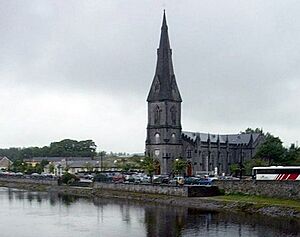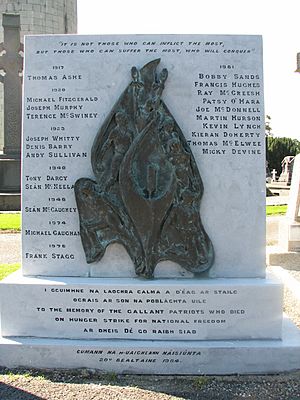Michael Gaughan (Irish republican) facts for kids
Quick facts for kids
Michael Gaughan
|
|
|---|---|
 |
|
| Born | 5 October 1949 Ballina, County Mayo, Ireland
|
| Died | 3 June 1974 (aged 24) Parkhurst Prison, Isle of Wight, England
|
| Cause of death | Hunger strike |
| Organization | Provisional IRA |
| Known for | Hunger strike of 64 days, from 31 March 1974 |
| Military career | |
| Allegiance | |
| Years of service | c. 1969–1974 |
| Battles/wars | The Troubles |
Michael Gaughan (born October 5, 1949 – died June 3, 1974) was an Irish republican who died during a hunger strike in 1974. He was held at Parkhurst Prison on the Isle of Wight, England. Michael Gaughan was one of 22 Irish republicans who died on hunger strike in the 20th century.
Contents
Early Life and Activism
Michael Gaughan was born in Ballina, County Mayo, Ireland, in 1949. He was the oldest of six children. He grew up in Healy Terrace and went to St Muredach's College in Ballina. After school, he moved from Ireland to England to find work.
While living in London, Michael Gaughan became involved with an Irish republican group. He joined the Provisional Irish Republican Army (IRA) as a volunteer. A volunteer is someone who freely offers to do something, often for a cause. He was part of a London-based unit.
In December 1971, Michael Gaughan was sentenced to seven years in prison. This was for his part in trying to raise money for the IRA by robbing a bank in north London. He was also found with two revolvers.
Imprisonment and Hunger Strike
Michael Gaughan was first held at HM Prison Wormwood Scrubs for two years. Then, he was moved to Albany Prison, a high-security prison on the Isle of Wight. While there, he asked to be treated as a political prisoner. This request was denied, and he was placed in solitary confinement. Solitary confinement means being held alone in a cell. Later, he was moved to Parkhurst Prison.
On March 31, 1974, Michael Gaughan began a hunger strike. He joined other prisoners, including Frank Stagg, Gerry Kelly, and sisters Dolours and Marian Price. Their main goal was to gain "political status." This meant they wanted to be treated like prisoners of war, not regular criminals.
Their demands included:
- Being allowed to wear their own clothes.
- A promise that they would not be put back in solitary confinement.
- The right to education and not having to do prison work.
- A set date for them to be moved to a prison in Ireland.
On April 10, 1974, Michael Gaughan and Frank Stagg were moved to the prison hospital. Two weeks later, they began to be force-fed.
Force-Feeding and Death
At that time, British prisons had a policy of force-feeding hunger strikers. This involved several guards holding the prisoner down. A feeding tube was then passed through a block placed in their mouth and down their throat.
Michael Gaughan's brother, John, visited him in prison. He described Michael's condition, saying his throat was badly cut from force-feeding and his teeth were loose. He had lost a lot of weight, dropping from 160 pounds to 84 pounds.
Michael Gaughan was force-fed 17 times, starting on April 22. The last time was the night before he died. After a hunger strike of 64 days, he passed away on June 3, 1974, at the age of 24.
The exact cause of his death was debated. The British government said he died of pneumonia. However, his family believed he died because prison doctors injured him during force-feeding. They said food went into a lung that was punctured by the feeding tube.
Michael Gaughan's death led to discussions in medical groups in England. Some doctors questioned if force-feeding without a patient's permission could be considered an assault. After his death, the British government stopped its policy of force-feeding hunger strikers. The remaining strikers were promised they would be moved to Irish prisons, but these promises were not kept.
Funeral and Legacy
Michael Gaughan's body was brought from London to Ireland. On June 7 and 8, 1974, thousands of mourners marched behind his coffin in Kilburn. An IRA honour guard walked beside it. A special church service was held for him.
His body was then taken to Dublin, where more mourners and another IRA guard of honour met it. Thousands of people came to see his coffin as it lay in state. The next day, his body was moved to Ballina, County Mayo.
The funeral mass was held on June 9 at St. Muredach's Cathedral. The procession then went to Leigue Cemetery. Michael Gaughan was given a full IRA funeral and buried in the republican plot. This is a special area where Irish republicans are buried. Over 50,000 people attended his funeral.
His coffin was covered with the same Irish flag that was used for the funeral of Terence McSwiney 54 years earlier. This flag was later used for the funeral of James McDade, another IRA member.
Michael Gaughan left a final message:
I die proudly for my country and in the hope that my death will be sufficient to obtain the demands of my comrades. Let there be no bitterness on my behalf, but a determination to achieve the New Ireland for which I gladly die. My loyalty and confidence is to the IRA and let those of you who are left carry on the work and finish the fight.
His death is remembered in the song Take me Home to Mayo, also known as The Ballad of Michael Gaughan. Many Irish musicians have performed this song.
Each year, there are talks and events to remember Michael Gaughan, Frank Stagg, and Sean McNeela (another IRA member who died on hunger strike). These events include a march to Leigue Cemetery in Ballina. In February 2006, a mural dedicated to Stagg and Gaughan was unveiled on the Falls Road in Belfast. A new mural was put up near his childhood home in August 2020.



